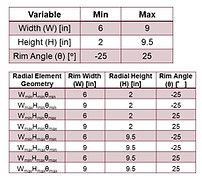RESEARCH PROJECT: RADIAL SUPPORT STRUCTURE DESIGN FOR A KNIT SMA TIRE
PROJECT OVERVIEW
From Sept. 2022 to May 2023, I worked on my undergraduate Honors Thesis under the Design of Active Materials and Structures Lab (DAMSL). The thesis focused on designing radial support elements for a non-pneumatic tire with knit shape memory alloy (SMA) treads. Research was conducted under supervision of Dr. Julianna Abel.
SKILLS DEVELOPED
-
Developing a model using coding
-
Designing an experiment
-
Leveraging material science principles in design

BACKGROUND
Rover Tires
Mobility is critical to exploring new terrains like Mars. NASA has identified that when their rovers fail, it's often due to the wheels failing. One example is the Curiosity Rover which landed on Mars in 2012. By 2013 the tires had sustained significant damage and the rover was in danger of not reaching it's destination.

Left front wheel of Curiosity Rover
Why do the rover tires fail?
The main reason is fatigue. The tire treads are made of stiff aluminum; driving over rocks causes them to bend and straighten repeatedly making the material brittle and eventually they fracture. A secondary reason is the harsh terrain on Mars.
Some key factors to consider when designing rover tires:
-
Non-pneumatic.
-
Light weight
-
Able to undergo large deformations
About Shape Memory Alloys (SMA)
A valuable material for creating rover tires is super elastic shape memory alloys (SMA). They have two characteristics that are advantageous for this application:
-
Shape memory properties (can be set to a certain configuration, deform, and still return to the original shape.
-
Super elastic properties (can undergo large strains and recover during unloading without permanent damage)
The SMA stress-strain curve shows that this material can undergo much more strain than typical metals without deformation

NASA SMA tire
The NASA Glenn Research center is taking advantage of SMA by developing a Nickel Titanium (NiTi) SMA tire made from interlocking springs. The tires can successfully undergo large deformations and return to its original shape. A possible drawback of this design is that the surface of the tire is relatively smooth compared to previous tire designs, which have grouser elements to increase traction.


The SMA stress-strain curve shows that this material can undergo much more strain than typical metals without deformation
Could knitting techniques help?
Using knitting techniques to create the SMA tread allows for control over the surface topography and the mechanical performance, such as the auxetic nature (related to how much energy is absorbed) and the stiffness. Adjusting the knitted pattern can create raised grooves that act as grousers (protruding elements that act like small cleats to increase traction against the ground).
In 2019, the Design of Active Materials and Structures Lab at the University of Minnesota developed a tire prototype with a simple knit NiTi tread. This tire successfully withstood large deformations without permanent damage showing that this concept is possible.



Swatch of custom knitted NiTi.
A second knit SMA prototype was developed in DAMSL that had a knit tread with grouser elements and the size was large enough to be tested on an ATV. My contribution involved designing the support elements within the tire that will bear the load of the ATV. This involved conducting compression testing on the support elements to understand how their shape affects performance. I also created a model to predict performance of the support elements that can be used in future rover tire prototyping,
RADIAL ELEMENT CHARACTERIZATION
A radial shape was used because it's a simple yet strong structure. There are three parameters that affect the shape of the radial element (see the diagram to the right for visuals of the parameters):
-
width
-
angle emerging from hub
-
height
Compression testing was done to determine how the parameters affect the load bearing properties


Test set up. This is one of the radial element geometries
I used an eight test DOE for to test the maximum and minimum of each parameter.

Design requirements for the tire to be tested on an ATV:

RESULTS
Affect of Width:
-
Minimum have an initial stiffness region
Affect of Angle:
-
Minimum angle causes consistently higher stiffness
Affect of Height:
-
Biggest impact on results.
-
Minimum height is much stiffer

TIRE ARCHITECTURE MODEL
Used statics to determine how each radial element would contribute to bearing the load of the overall tire for a given deflection.

Process of developing the model:
-
Create a curve fit for each geometry so I can input a displacement and receive a force
-
Based on the overall displacement, find the individual displacement of each engaged radial element then input into the curve fit
-
Sum all forces in the y direction

User inputs into the model and the output:

RESULTS
Based off of the medium geometry, 270 radial elements are needed to meet design requirements

TIRE PROTOTYPE



The development of the second SMA tire prototype was led by Berik Kallevig. Left are close up images of the prototype. Below are images of the tire on an ATV for testing.



The graph to the right compares the load bearing behavior of the tire prototype to the prediction model I made. The red line is the projected load vs displacement from the model and the other colors are various points around the tire tread.
